At 2001, Suzuki introduced a new GSX-R model that replaced the largest and most powerful model of the GSX-R series sport bike, the GSX-R1100, with the all new GSX-R1000. As the model name revealed, the engine's cylinder displacement was roughly 1,000 cc (61 cu in), about 100 cc smaller than its predecessor. The GSX-R1000 was not just an enlarged version of the GSX-R750, although it shared many features with its little brother. The main frame is the same in both models, but the material used on the big brother was .5 mm (0.020 in) thicker. Suzuki claimed the torsional rigidity of the frame had increased 10% in comparison with the GSX-R750.
 |
| Suzuki GSXR 1000 Sportbike |
 |
| Suzuki GSXR 1000 Sportbike |
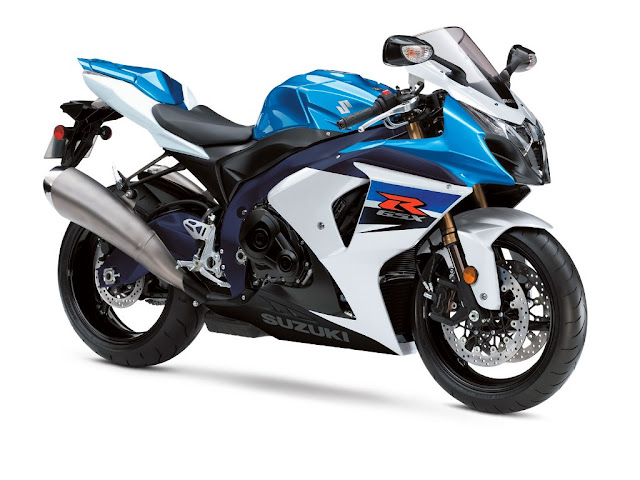 |
| Suzuki GSXR 1000 Sportbike |
The GSX-R1000 engine was a redesigned GSX-R750 engine. The R1000 had a 1 mm (0.039 in) bigger bore and 13 mm (0.51 in) longer stroke, newly designed pistons with lower crown, and gear-driven counter balancer. The engine weighed 130 lb (59 kg) which was slightly heavier than the 750 engine but 31 lb (14 kg) lighter than the engine of the GSX1300R. The performance of the engine is a peak of 160 bhp (120 kW) at 9,500 rpm, as measured on the crank and 143 hp (107 kW), when measured on the rear wheel with small variations between different instances of the same model. The redline is set at 12,000 rpm. The maximum torque of the engine is 80 ft·lbf (110 N·m) at 8,000 rpm. Combined with a total (dry) weight of 374 lb (170 kg) this gives the GSX-R1000 a top speed of 179 mph (288 km/h), a 1/4 mile time of 10.1 seconds at 141.7 mph (228.0 km/h), and a 0 to 100 km/h (62 mph) time of 3 seconds.
 |
| Suzuki GSXR 1000 Sportbike |
 |
| Suzuki GSXR 1000 Sportbike |
 |
| Suzuki GSXR 1000 Sportbike |
 |
| Suzuki GSXR 1000 Sportbike |
Using titanium for the exhaust down pipe(K1 model link pipe is black, K2 model link pipe is polished titanium) and the inside of the silencer, enabled the 1000s exhaust system to become 4 lb (1.8 kg) lighter than that of the 750. Titanium was also used in the front fork (Titanium-nitride) to coat the stanchions. An exhaust tuning valve had been mounted inside the exhaust pipe. Using a servo the system dynamically adjusted the exhaust back pressure, according to engine speed, throttle position, and gear selection for increased torque, lower emissions, and decreased noise—the (stock) exhaust noise of the GSX-R1000 is notably lower than that of the GSX-R600.
With the 2001 model of the GSX-R1000, the 1998 Yamaha YZF-R1 was finally surpassed with the GSX-R being lighter and more powerful.
The 2001 model carried over to 2002 with minimal changes. 2002 introduced i.a. modifications to the fuel pump, clutch, front axle, torque link, mirrors, and luggage hooks. The manual fast-idle was replaced with a computer operated implementation (the "STV servo"). New colors, and new GSXR stickers.
 |
| Suzuki GSXR 1000 Sportbike |
 |
| Suzuki GSXR 1000 Sportbike |
 |
| Suzuki GSXR 1000 Sportbike |
 |
| Suzuki GSXR 1000 Sportbike |
The Yamaha XT660 is dual-purpose on/off road motorcycles released by Yamaha Motors as a replacement for the XT600. It is a development of the original XT series ('X' stands for CROSS, 'T' for TRAIL), a line of motorcycles inspired by those used on the Paris Dakar rally. The first XT was released in 1976. A five-valve version of the 660 cc engine was used in a number of MZ (MuZ) motorcycles, including the MZ Skorpion, Baghira and Mastiff.
| Yamaha XT 660 Supermoto |
 |
| Yamaha XT660X 2005 Motorcycle Desktop Wallpaper |
 |
| 2010 Yamaha XT660R Grande |
 |
| Yamaha XT660-g |
 |
| Yamaha XT660-c |
 |
| Yamaha XT660X 2004 |
 |
| Yamaha XT660 Supermoto |
 |
| Yamaha XT660 Supermoto |
 |
| Yamaha XT660R Reina Absoluta no Segemento Trail de Media Cilindrada |
 |
| Yamaha XT660-j |
 |
| Yamaha XT660 Supermoto |
.JPG) |
| Yamaha XT660 |
Specifications
Engine:
- Engine Type- Liquid-cooled, 4-stroke, SOHC 4-valve, single
- Displacement- 660 cc
- Bore x Stroke- 100.0 x 84.0 mm
- Compression Ratio- 10.0 : 1
- Lubrication System- Dry sump
- Fuel Management- Electronic fuel injection
- Ignition- TCI
- Starter System- Electric
- Fuel Tank Capacity- 15 L
- Final Transmission- Chain drive
- Transmission- 5-speed
Dimensions:
- Length- 2240 mm
- Width- 845 mm
- Height- 1230 mm
- Seat Height- 865 mm
- Wheelbase- 1505 mm
- Ground Clearance- 210 mm
- Wet Weight- 181 kg with 15 litres of fuel
Chassis:
- Suspension Front- Telescopic fork
- Suspension Rear- Monocross
- Brakes Front- Single disc
- Brakes Rear- Single disc
Tires XT660R/Z:
- Tire Front- 90/90-21 M/C
- Tire Rear- 130/80-17 M/C
Tires XT660X:
- Tire Front- 120/70R 17M/C
- Tire Rear- 160/60R 17M/C
Two other versions of this motorcycle are being produced alongside the XT660R – the XT660X, a more street-oriented supermoto version, and the XT660Z Ténéré, an adventure touring version,. All versions utilise the same engine and share some chassis components.
The Honda CRF450R has been at the head of the class pretty much every year since its introduction in 2002. As great as those bikes were, they were not without fault. Year by year handling, engine and suspension issues were gradually ironed out. Then in 2009 Honda took a huge leap, introducing fuel injection and a revised engine, frame and suspension. We’re talking about a total rework here. KYB replaced Showa as suspension supplier, frame geometry was changed, the swingarm was lengthened and the plastic was updated. As such, nobody expected the 2010 model to have much more than bold new graphics, which it does have by the way.
Pretty much everyone is familiar with the 450 Honda. The four-valve, uni-cam engine is relatively simple and has grown to be more reliable with each passing year. The transmission and engine oil are separate, allowing optimum lubes for each application and no chance of dirty transmission oil circulating through the engine. At a claimed 234.8 pounds, the bike’s weight is right in there with the rest of the 450 class. Going to fuel injection last year cured some of the 450’s bad habits, but not completely. You never forget you’re on a big, serious motocross bike.
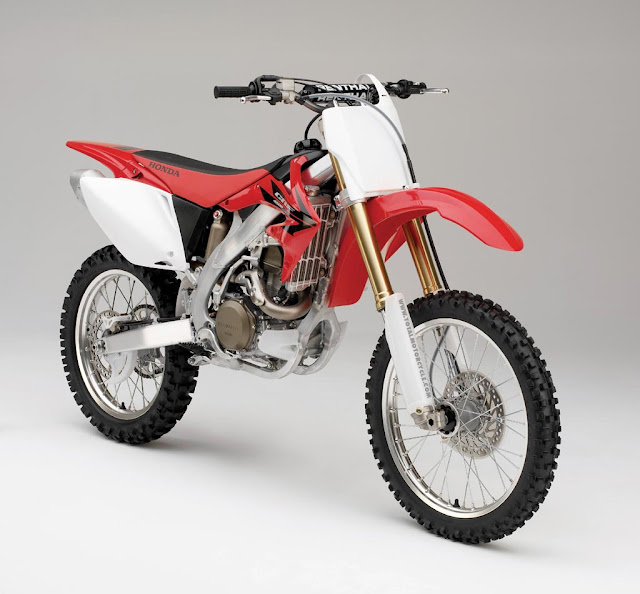 |
| Honda CRF450R Motocross |
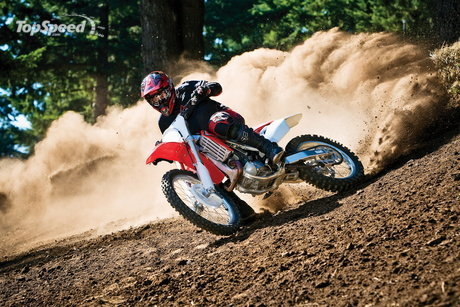 |
| Honda CRF450R Motocross |
 |
| Honda CRF450R Motocross |
The fuelie 450 starts reasonably well for a big thumper, but not great. Once running it pulls too…boy does it ever pull! Instant throttle response and raw grunt from bottom to top make this a brutally effective motocross engine, mated to a slick shifting tranny and a smooth clutch. Fuel injection hasn’t eliminated all of the classic big four-stroke nastiness; the CRF450R will ‘cough and die’ at inopportune times at low rpm for no apparent reason.
When it pulls that unfriendly little stunt the 450 still requires a bunch of very hefty boots and navy curses to relight. That tendency, along with a light flywheel and tall first gear, conspire to make this a very difficult bike to ride anywhere but on a motocross track or wide, fast trails. If you are an East Coast off-road guy expect to spend some money re-mapping the fuel injection system, which is now easier to access without removing the fuel tank, and perhaps adding a flywheel weight. Let’s just say on the track the CRF has a completely different face than the one it wears when forced into playbike mode.
The CRF is a tidy handler that rewards a precise rider. That big, powerful engine is the biggest part of the handling package. At times it is very easy to get in over your head by giving the throttle an overzealous twist.
 |
| Honda CRF450R Motocross |
 |
| Honda CRF450R Motocross |
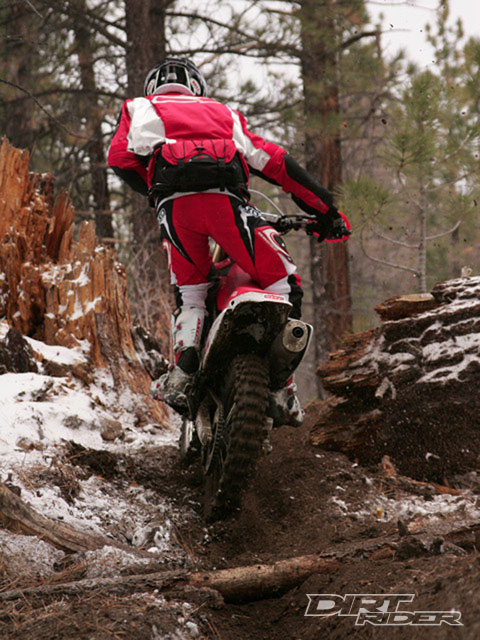 |
| Honda CRF450R Motocross |
 |
| Honda CRF450R Motocross |
 |
| Honda CRF450R Motocross |
 |
| Honda CRF450R Motocross |
 |
| Honda CRF450R Motocross |
The Ducati 848 is a sport bike, with a 849 cc (51.8 cu in) V-twin engine, manufactured by Ducati. It was announced on November 6, 2007 for the 2008 model year and replaces the 749, although the 848 model name was already listed on the compatible parts table for the 1098 fuel tank, giving away the secret a few months early. The 848 makes a tested 115.6 hp (86 kW) at 10,000 rpm and 62 lb·ft (84.1 N·m) at 8,250 rpm.[3] With a manufacturer claimed dry weight of 168 kg (370 lb), the 848 undercuts its larger displacement sibling, the 1198, by 5 kg (11 lb). In August 2010, Ducati announced the 848 Evo, as the evolution of the model. The bike featured small revisions such as a black swingarm, Mono-block Brembo brake calipers, steering damper mount as well as some very minor engine revisions.
 |
| Ducati 848 |
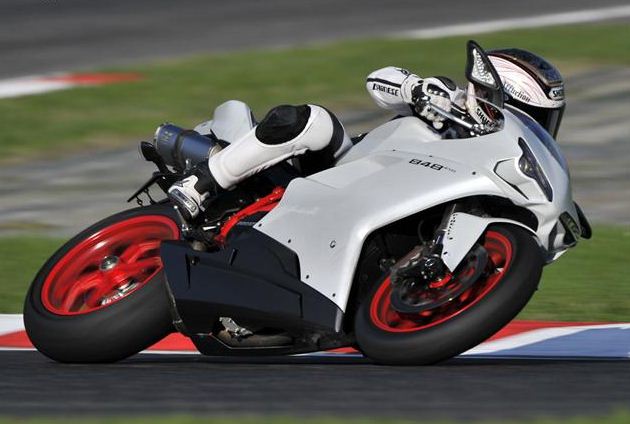 |
| Ducati 848 |
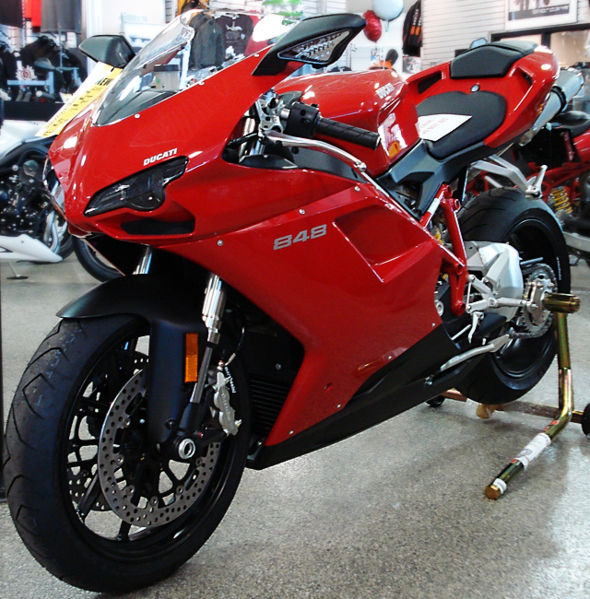 |
| Ducati 848 |
While most of the chassis components are identical to the 1098/1198, the motor was an all new design in 2008. Producing roughly 116 hp at the rear wheel it out performs the revered Ducati 916 that had a hard time producing more than 100hp and even the upgraded Ducati 998 that produced 110 hp at the rear wheel. The "Testastretta Evoluzione" uses a 94 x 61.2mm bore and stroke for 849cc of displacement despite the bikes moniker of 848. The motor casings were constructed using a new vacuum die-casting method called Vacural that helps the engine weigh seven lbs less than the Ducati 749. The intake valves were increased 2.5mm from the Ducati 749 numbers to 39.5mm. The exhaust valves were enlarged 1.5mm to 32mm. The valve angles are identical to the Ducati 1098. The bike uses a pair of elliptical shaped 56mm throttle bodies fashioned after MotoGP designs.
 |
| Ducati 848 |
 |
| Ducati 848 |
 |
| Ducati 848 |
The 2011 Ducati 848 Evo featured minor changes to the engine, including new Marelli throttle bodies, revised cylinder heads with straighter intake ports and reshaped combustion chambers. Ducati claimed these changes would result in a 6-hp increase, bringing output to 140 measured at the crank, however Cycle World Magazines first dyno test of the engine showed a mere 1.6 hp increase over the previous motor.
The 848 shares more physical and technical design elements with the stronger 1098/1198 than its predecessor, the 749, did with the 999. In many cases the 1098/1198 and the 848 are identical right down to the part numbers.
| Ducati 848 |
| Ducati 848 |
| Ducati 848 |
The two bikes use the same bodywork, including the fuel tank. With the exception of the steering damper mount, the frame between the bikes is the same, which results in identical wheelbase and rake and trail numbers. The second generation 848 Evo features the same monoblock brakes and the same frame with the steering damper mount as the 1098/1198. The rear suspension, including the suspension linkage is the same, using identical Showa shocks. Many components of the exhaust system are shared, including the exhaust canisters that house the muffler and catalytic converter.
Despite the difference in engine displacement, the two bikes share valve angles and magnesium valve covers. The oil cooler and radiator are also very similar. The transmissions are different with the ratios on the 848 being closer together.
 |
| Ducati 848 |
 |
| Ducati 848 |
One of the more notable differences between the two bikes (aside from the engine) is the brakes. On the 848, the four-caliper Brembo front brakes are cast rather than machined monoblocs. The 848 requires greater braking effort than the 1098/1198, in spite of its lighter weight.
 |
| Ducati 848 |
 |
| Ducati 848 |
Imágenes de motos te hemos presentado muchas a lo largo de las muchas categorías que te presentamos. Pero ningunas son tan espectaculares como las que verás a continuación. ¿No nos crees? Pues sigue leyendo y verás. Para comenzar nada mejor que estos dos pilotos llevando sus máquinas al máximo de sus capacidades. ¡Impresionantes imágenes! Y acabaremos con dos imágenes en las que podemos ver la tensión y la emoción de las competiciones de motos. ¡Geniales imágenes! Deseamos que te hayan gustado las imágenes de motos anteriores tanto como nosotros hemos disfrutados reuniéndolas para ti.
 |
| Imagenes de Motos |
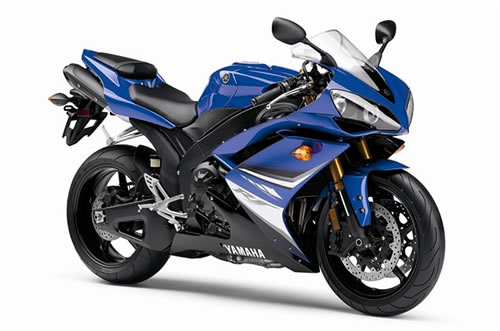 |
| Yamaha RL |
 |
| Motos da Yamaha |
 |
| Imagenes de Motos |
 |
| Motos Y Moteros |
 |
| Motos Modernas |
 |
| Fotos de Motos Tuning |
 |
| Moto |
 |
| Yamaha |
 |
| Motocicleta |
 |
| Seguros de Motos en la ciudad de Chivilcoy Estudio Giaccone ATM Seguros |
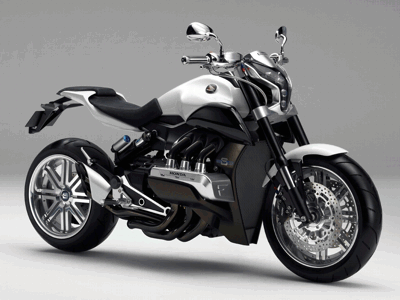 |
| Motos |
 |
| Motos Nuevas |
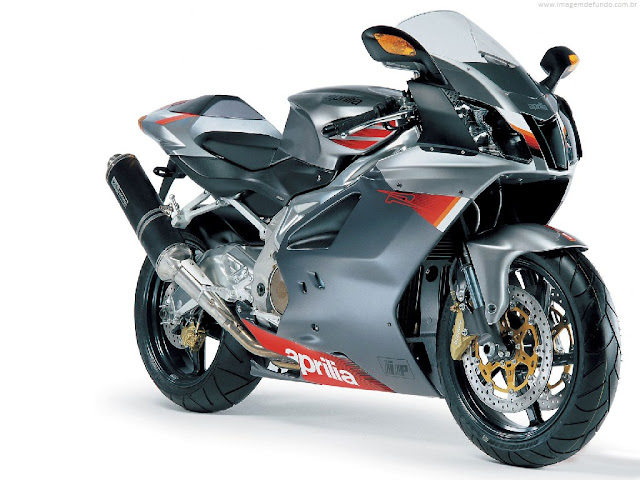 |
| Motos Tunadas |
 |
| Imagenes de Motos |
 |
| Moto Tuning |



